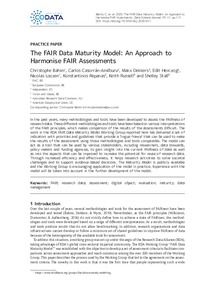| dc.contributor.author | Bahim, Christophe | |
| dc.contributor.author | Casorrán-Amilburu, Carlos | |
| dc.contributor.author | Dekkers, Makx | |
| dc.contributor.author | Herczog, Edit | |
| dc.contributor.author | Loozen, Nicolas | |
| dc.contributor.author | Repanas, Konstantinos | |
| dc.contributor.author | Russell, Keith | |
| dc.contributor.author | Stall, Shelley | |
| dc.date.accessioned | 2021-04-06T19:47:01Z | |
| dc.date.available | 2021-04-06T19:47:01Z | |
| dc.date.issued | 2020 | |
| dc.identifier.citation | Bahim, C., Casorrán-Amilburu, C., Dekkers, M., Herczog, E., Loozen, N., Repanas, K., Russell, K. and Stall, S. (2020) The FAIR Data Maturity Model: An Approach to Harmonise FAIR Assessments. Data Science Journal, 19: 41. 7pp. DOI: http://doi.org/10.5334/dsj-2020-041 | en_US |
| dc.identifier.uri | http://hdl.handle.net/11329/1534 | |
| dc.identifier.uri | http://dx.doi.org/10.25607/OBP-1030 | |
| dc.description.abstract | In the past years, many methodologies and tools have been developed to assess the FAIRness of research data. These different methodologies and tools have been based on various interpretations of the FAIR principles, which makes comparison of the results of the assessments difficult. The work in the RDA FAIR Data Maturity Model Working Group reported here has delivered a set of indicators with priorities and guidelines that provide a ‘lingua franca’ that can be used to make the results of the assessment using those methodologies and tools comparable. The model can act as a tool that can be used by various stakeholders, including researchers, data stewards, policy makers and funding agencies, to gain insight into the current FAIRness of data as well as into the aspects that can be improved to increase the potential for reuse of research data. Through increased efficiency and effectiveness, it helps research activities to solve societal challenges and to support evidence-based decisions. The Maturity Model is publicly available and the Working Group is encouraging application of the model in practice. Experience with the model will be taken into account in the further development of the model. | en_US |
| dc.language.iso | en | en_US |
| dc.rights | Attribution 4.0 International | * |
| dc.rights.uri | http://creativecommons.org/licenses/by/4.0/ | * |
| dc.subject.other | FAIR | en_US |
| dc.subject.other | Research data | en_US |
| dc.subject.other | Assessment | en_US |
| dc.subject.other | Digital object | en_US |
| dc.subject.other | Data management | en_US |
| dc.subject.other | Evaluation | en_US |
| dc.subject.other | Maturity | en_US |
| dc.title | The FAIR Data Maturity Model: An Approach to Harmonise FAIR Assessments. | en_US |
| dc.type | Journal Contribution | en_US |
| dc.description.refereed | Refereed | en_US |
| dc.format.pagerange | 7pp. | en_US |
| dc.identifier.doi | https://doi.org/10.5334/dsj-2020-041 | |
| dc.subject.parameterDiscipline | Parameter Discipline::Administration and dimensions | en_US |
| dc.subject.dmProcesses | Data Management Practices::Data archival/stewardship/curation | en_US |
| dc.bibliographicCitation.title | Data Science Journal | en_US |
| dc.bibliographicCitation.volume | 19 | en_US |
| dc.bibliographicCitation.issue | Article 41 | en_US |
| dc.description.sdg | 14.A | en_US |
| dc.description.maturitylevel | TRL 7 System prototyping demonstration in an operational environment (ground or space) | en_US |
| dc.description.bptype | Manual (incl. handbook, guide, cookbook etc) | en_US |
| obps.contact.contactname | Christophe Bahim | |
| obps.contact.contactemail | christophe.bahim@pwc.com | |
| obps.resourceurl.publisher | https://datascience.codata.org/articles/10.5334/dsj-2020-041/ | en_US |
 Repository of community practices in Ocean Research, Applications and Data/Information Management
Repository of community practices in Ocean Research, Applications and Data/Information Management

